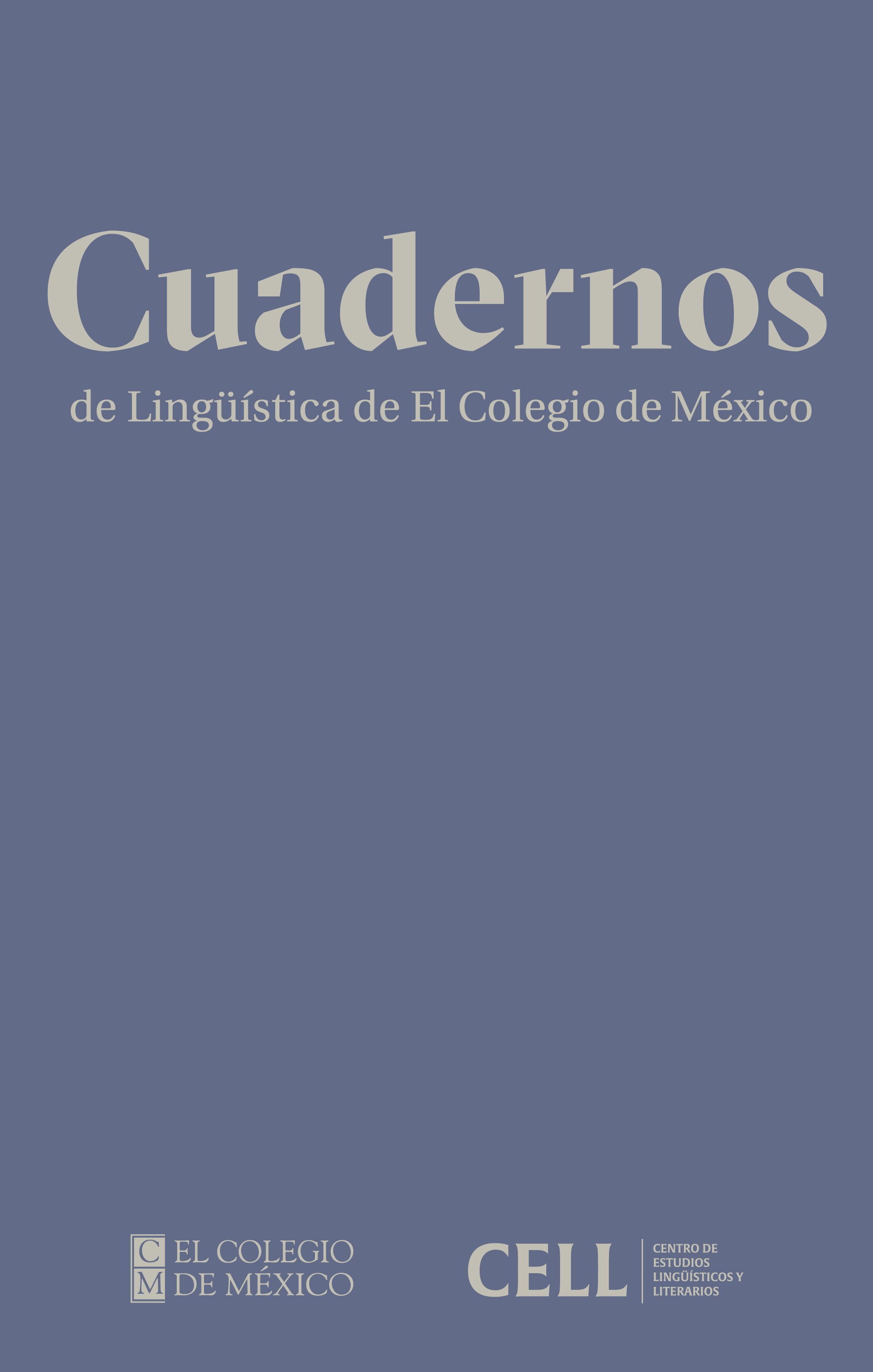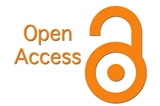Palatalization and contexts of palatalization of *k/*k’: a path of phonological change in Mayan languages
DOI:
https://doi.org/10.24201/clecm.v9i0.219Keywords:
mayan languages, palatalization context, assimilation, dissimilation, root phonotacticsAbstract
Synchronic and diachronic palatalization of velar stops in Mayan languages is a well-studied phenomenon. Although the change *k(’) > tʃ(ʼ), in several of these languages, seems to be a persistent one, authors who have described it propose that in each language or subgroup of the family there are special conditions or different contexts in which palatalization ocurrs, either to argue that the change is an independent innovation or the result of areal diffusion. Based on the analysis of Mayan languages that manifest palatalization of k(’) (sinchronic or diachronic), as well as on the examination of the lexical diffusion patterns of Mam dialects and Eastern languages, two palatalization rules are proposed: one that responds to a process of assimilation (before and after front vowels), and another one that responds to a process of dissimilation (when the velar stop precedes dorsal consonants in the same root). In each language or subgroup of languages both rules or only one of them can be active. The existence of an intermediate stage in this change is also proposed: *k(ʼ) > *kʲ(ʼ) > tʃ(ʼ). When a language does not palatalize a velar stop in some words, it would be not only due to the limited scope of the diffusion of the rules, since the change (either independently or by diffusion) can be blocked because of root phonotactics. In view of these and other factors such as loanwords in the study of palatalization of velar stops in Mayan languages, it will be posible to observe in detail the state of lexical diffusion of Classic Ch’olan, as well as the level of interaction that q’anjob’alan languages had with the languages of the lowlands.
+
Downloads
References
Academia de Lenguas Mayas de Guatemala. 2003a. Jit’il q’anej yet Q’anjob’al. Vocabulario Q’anjob’al. Guatemala: ALMG.
Academia de Lenguas Mayas de Guatemala. 2003b. Tyolb’ajil yolb’a’aj. Vocabulario Tektiteko. Guatemala: ALMG.
Academia de Lenguas Mayas de Guatemala. 2001a. Jiilt’an Maya Itza. Vocabulario Itza. Guatemala: ALMG.
Academia de Lenguas Mayas de Guatemala 2001b. Tqan Qayol. Vocabulario Awakateko, Guatemala: ALMG.
Academia de Lenguas Mayas de Guatemala. 2001c. Tihtzoti’ yet abxubal Popti’. Guatemala: ALMG.
Acuña, René (Ed.). 1993. Bocabulario de Maya Than. México: Universidad Nacional Autónoma de México.
Andrés, Domingo; Dakin, Karen; Juan, José; López, Leandro & Peñalosa, Fernando. 1996. Diccionario Akateko-Español. USA: Proyecto Lingüístico Francisco Marroquín.
Arzápalo Marín, R. (ed.). 1995. Calepino de Motul. México: Universidad Nacional Autónoma de México.
Asicona Ramírez, Lucas, Méndez Rivera, Domingo & Xinic Bop, Rodrigo Domingo. 1998. Diccionario Ixil de San Gaspar Chajul. La Antigua Guatemala: Proyecto Lingüístico Francisco Marroquín.
Aulie, H. Wilbur & de Aulie, Evelyn W. 1978. Diccionario chol de Tumbalá, Chiapas, con variaciones dialectales de Tila y Sabanilla. México: Instituto Lingüístico de Verano.
Becquey, Cédric. 2014. Diasystème, Diachronie: Etudes comparées dans les langues cholanes. Ámsterdam: Universidad de Ámsterdam (Tesis de doctorado.)
Bennett, Ryan. 2016. Mayan phonology. Language and Linguistic Compass. 10(10). 469–514. DOI: https://doi.org/10.1111/lnc3.12148
Boot, Eric. 2004. Vocabulary in the Ch’olt’í’ Language. A Transcription of the ‘Bocabulario Grande’ by Fray Francisco Morán (1695). famsi.org/mayawriting/dictionary/boot/cholti_moran1695_revised.pdf (Consultado el 7 de diciembre de 2004.)
Boot, Eric. 2009. The updated preliminary Classic Maya-English, English-Classic-Maya Vocabulary. http://www.mesoweb.com/ resources/vocabulary/Vocabulary 2009.01.pdf (Consultada el 2 de agosto de 2020.)
Brown, Cecil & Wichmann, Søren. 2011. Syllable nuclei of ptoto-Mayan disyllabic stems. En Avelino, Heriberto (ed.), New perspectives in Mayan linguistics, 316–342. Cambridge: Cambridge Scholars Publishing.
Brown, Cecil & Wichmann, Søren. 2004. Proto-Mayan syllable nuclei. International Journal of American Linguistics. 70(2). 128–186. DOI: https://doi.org/10.1086/424553
Campbell, Lyle & Kaufman, Terrence. 1990. Lingüística mayance:¿Dónde nos encontramos ahora? En England, Nora C. & Elliot, S. R. (eds.), Lecturas sobre la lingüística maya, 51–58. La Antigua Guatemala: Centro de Investigaciones Regionales de Mesoamérica.
Campbell, Lyle. 2017. Mayan history and comparison. En Aissen, Judith Nora C. England, Nora C. & Zavala Maldonado, Roberto (eds.), The Mayan languages, 43-61. Routledge. https://www.routledgehandbooks.com/doi/10.4324/9781315192345.ch3 (Consultado el 15/12/2020). DOI: https://doi.org/10.4324/9781315192345-3
Campbell, Lyle. 1999. Historical Linguistics. An Introduction. Cambridge: Massachusetts Institute for Technology Press.
Campbell, Lyle. 1984. The implications of Mayan historical linguistics for glyphic research. En Justeson, John & Campbell, Lyle (eds.), Phoneticism in Mayan Hieroglyphic Writing, 1–16. Albany: State University of New York.
Campbell, Lyle. 1977. Quichean linguistic prehistory. University of California Press, Berkeley.
Campbell, Lyle. 1974. Quichean palatalized velars. International Journal of American Linguistics. 40(2): 132–134. DOI: https://doi.org/10.1086/465296
Cruz Aguilar, Manuel & Gómez Jiménez, Pablo. 2002. Vocabulario tojol-ab’al-español. México: Gobierno del Estado de Chiapas.
Dayley, Jon. 1985. Tzutujil grammar. Berkeley, CA: University of California Press.
England, Nora C. 2001. Introducción a la gramática de los idiomas mayas. Ciudad de Guatemala, Guatemala: Cholsamaj.
England, Nora C. 1983. A Grammar of Mam, a Mayan Language. Austin: University of Texas Press. DOI: https://doi.org/10.7560/727267
Fox, J. Alan. 1978. Proto-Mayan Accent, Morpheme Structure Conditions, and Velar Innovations. The University of Chicago, Chicago.(Tesis doctoral.)
Grimes, James L. 1969. The palatalized velar stop in Proto-Quichean. International Journal of American Linguistics. 35(1): 20–24. DOI: https://doi.org/10.1086/465035
Grube, Nikolai. 1994. Observations on the history of Maya hieroglyphic writing. http://www.mesoweb.com/pari/publications/RT09/Observations.pdf (Consultado el 08/03/2021).
Heine, Bernd & Kuteva, Tania. 2003. On contact-induced grammaticalization. Studies in language. 27(3): 529–572. DOI: https://doi.org/10.1075/sl.27.3.04hei
Herrera Zendejas, Esther. 2014. Mapa fónico de las lenguas mexicanas. Formas sonoras 1 y 2. México: EL Colegio de México.
Hopkins, Nicolas A. 2012. A dictionary of the Chuj Mayan language. Tallahassee, Florida: Jaguar Tours.
Hull, Kerry. 2005. An Abbreviated Dictionary of Ch’orti’ Maya. http://www.famsi.org/reports/03031/03031.pdf (Consultado el 14/11/2011.)
Hurley, Alfa & Ruiz Sánchez, Agustín. 1978. Diccionario tzotzil de San Andrés con variaciones dialectales. México: Instituto Lingüístico de Verano.
Ikeda, Mitsuho & Pérez Morales, Walter Orlando. 2001. Diccionario del mam-español de Comitancillo. http://www.cscd.osaka-.ac.jp/user/rosaldo/Mam_Esp_DICC_COM.html (Consultado el 10/10/2020.)
Justeson, John S.; Norman, William M.; Campbell, Lyle & Kaufman, Terrence. 1985. The Foreign Impact on Lowland Mayan Language and Script. Nueva Orleans: Middle American Research Institute. Tulane University.
Kaufman, Terrence S. & Norman, William M. 1984. An outline of Proto-Cholan phonology, morphology and vocabulary, Phoneticism in Mayan Hieroglyphic writing, 77–166, John S. Justeson & Lyle Campbell (eds.). Albany, Nueva York: Institute for Mesoamerican Studies.
Kaufman, Terrence. 2003. A preliminary Mayan etymological dictionary.<http://www.famsi.org/reports/01051/pmed.pdf> (Consultado el 15 de abril de 2008.)
Kaufman, Terrence. 1990. Algunos rasgos estructurales de los idiomas mayances con referencia especial al k’iche’. En England, Nora C. & Elliot, S. R. (eds.), Lecturas sobre la lingüística maya, 59–114. La Antigua Guatemala: Centro de Investigaciones Regionales de Mesoamérica.
Kaufman, Terrence. 1969. Teco: A new Mayan language. International Journal of American Linguistics. 35(2): 154–174. DOI: https://doi.org/10.1086/465050
Kaufman, Terrence. 1967. Preliminary Mocho’ vocabulary. Department of Linguistics Working Paper No. 5, University of California, Berkeley. Ms.
Kaufman, Terrence. 1964. Materiales lingüísticos para el estudio de las relaciones internas y externas de la familia de idiomas mayanos. En Vogt, E. & Ruz, Alberto. (eds.), Desarrollo cultural de los mayas, 81–136. México: Universidad Nacional Autónoma de México.
Kiparsky, P. 2003. The phonological basis of sound change. Brian, Joseph D. & Janda, Richard D. (eds.), The Handbook of Historical Linguistics, 313–342. Oxford: Blackwell Publishing.
Knowles, Susan. M. 1984. A Descriptive Grammar of Chontal Maya (San Carlos Dialect). Tulane: Universidad de Tulane. (Tesis doctoral.)
Lacadena García-Gallo, Alfonso. 2003. El Corpus Glífico de Ek’ Balam,
Yucatán, México. Fundación para el Avance de los Estudios Mesoamericanos, Inc. http://www.famsi.org/reports/01057es/01057esLacadenaGarciaGallo01.pdf (Consultado el 20/01/2021.)
Laughlin, Robert M. 2007. Mol cholobil k’op ta sotz’leb. El gran diccionario tzotzil de San Lorenzo Zinacantán. México: Centro de Investigaciones y Estudios Superiores en Antropología Social/Consejo Nacional para la Cultura y las Artes.
Law, Danny; Robertson, John; Houston, Stephen; Zender, Mark & Stuart, David. 2014. Areal shifts in Classic Mayan phonology. Ancient Mesoamerica, (25): 357-366 doi:10.1017/S0956536114000273. DOI: https://doi.org/10.1017/S0956536114000273
Lenkersdorf, Carlos. 2010. Diccionario tojolabal-español, idioma mayense de Chiapas. México. https://www.rebelion.org/docs/123767.pdf (Consultado el 07/07/2011).
McQuown, Norman. 1955. The indigenous languages of Latin America. DOI: https://doi.org/10.1525/aa.1955.57.3.02a00080
American Anthopologist 57(3): 501–570. doi: https://doi.
org/10.1525/aa.1955.57.3.02a00080
McQuown, Norman. 1956. The Classification of the Mayan Languages. International Journal of American Linguistics 22(3): 191–195. DOI: https://doi.org/10.1086/464365
Montejo, Víctor D. 2008. Diccionario de la lengua maya Popb’al Ti’. Fundación para el Avance de los Estudios Mesoamericanos, Inc. http://www.famsi.org/reports/95017es/ (Consultado el 10/10/2020).
Mora-Marín, David. 2008. Análisis epigráfico y lingüístico de la escritura
maya del periodo Preclásico Tardío: Implicaciones para la historia sociolingüística de la región. En J.P. Laporte; Arroyo, B. & Mejía, H. (eds.), XXI Simposio de Arqueología en Guatemala, 1056–1079. Museo Nacional de Arqueología y Etnología, Guatemala.
Palosaari, Naomi. 2011. Topics in Mocho’ phonology and morphology.
Utah: University of Utah. (Tesis doctoral).
Pérez, Eduardo (B’aayil); Zoila Blanca; García Jiménez, Luz & (Ajb’ee) Jiménez, Odilio (Ajb’ee). 2000. Tz’ixpub’ente tiib’ qyool: variación dialectal en Mam. Ciudad de Guatemala: Cholsamaj.
Pérez Mendoza, Francisco & Hernández Mendoza, Miguel. 1996. Diccionario Tz’utujil. La Antigua Guatemala: Proyecto Lingüístico Francisco Marroquín, Fondo de Desarrollo Indígena Guatemalteco.
Polian, Gilles. 2018. Diccionario multidialectal del tseltal. México: Instituto Nacional de Lenguas Indígenas; Centro de Investigaciones y Estudios Superiores en Antropología Social.
Robertson, John & Houston, Stephen. 2015. The Huastec problem. A linguistic and archaeological perspective. En K. A. Faust y K. N. Richter (eds.), The Huasteca. Culture, History and Interregional Exchange, 19–36. Norman: University of Oklahoma Press.
Robertson, John. 1992. The History of tense/aspect/mood/voice in the Mayan verbal complex. Austin: University of Texas Press. DOI: https://doi.org/10.7560/720756
Schumann Gálvez, Otto. 2012. Introducción al chontal de Tabasco. México: Universidad Nacional Autónoma de México. DOI: https://doi.org/10.22201/cimsur.9786070239281p.2012
Schumann Gálvez, Otto. 1973. La lengua chol de Tila (Chiapas). México: Universidad Nacional Autónoma de México.
Slocum, Mariana C.; Gerdel, Florencia L. & Cruz Aguilar, Manuel. 1999. Diccionario Tzeltal de Bachajón, Chiapas. México: Instituto Lingüístico de Verano.
Weinreich, Uriel. 1953. Languages in contact. Findings and problems. La Haya: Muton.
Wichmann, Søren. 2006. A new look at linguistic interaction in the lowlands as a background for the study of Maya codices. En Valencia Rivera, Rogelio & Le Fort, Geneviève (eds.), Sacred Books, Sacred Languages: Two Thousand Years of Ritual and Religious Maya Literature. Proceedings of the 8th European Maya Conference, Madrid, November 25-30, 2003. Acta Mesoamericana, 18, 45–64. Markt Schwaben: Verlag.
Published
How to Cite
-
Abstract795
-
PDF (Español)170
-
XML (Español)96
-
EPUB (Español)36
-
Kindle (Español)129
-
MP3 (Español)22
Issue
Section
License
Copyright (c) 2022 Martín Sobrino Gómez

This work is licensed under a Creative Commons Attribution-NonCommercial-NoDerivatives 4.0 International License.
Authors retain copyright of their work and are free to disseminate it, make copies for any use, and/or deposit in any repository or archive of their choice, but they grant Cuadernos de Lingüística de El Colegio de México the right to publish the work for the first time. Authors agree to acknowledge Cuadernos de Lingüística de El Colegio de México as the site of original publication of their article / note / review through proper citation.
Articles appearing in Cuadernos de Lingüística de El Colegio de México are made available to readers under a Attribution-NonCommercial-NoDerivatives 4.0 International.









